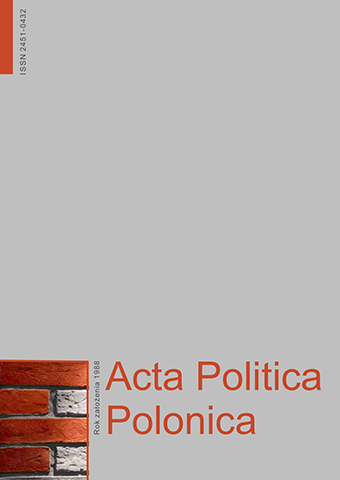
ISSN: 2451-0432
OAI
DOI: 10.18276/ap.2017.41-04




Issue archive /
3/2017 (41)
Egzemplifikacja efektu inkumbenta w wyborach bezpośrednich kierowników gminnej egzekutywy w Polsce i jego strukturalne uwarunkowania
(Exemplification of the incumbent effect in direct elections of communal executive managers in Poland and its structural determinants)
| Authors: |
Sławomir
Bartnicki
Uniwersytet w Białymstoku, Instytut Socjologii i Kognitywistyki |
| Keywords: | determinants of incumbents’ dominance communal executive direct elections |
| Data publikacji całości: | 2017 |
| Page range: | 14 (55-68) |
Abstract
The article presents structural determinants of dominance of incumbents in direct elections of rural commune heads and town mayors in Poland. One of the key determinants is the role of voters, whose level of preference for incumbents is moderated in a non-linear way by the number of commune inhabitants. The population of the commune also affects the intensity of measurable variables characterizing communes, which reciprocally moderate re-election probability. The effectiveness of incumbents’ intentional activities aimed to improve their chances for re-election is also dependent of the commune population. The analysis shows that the dominance of incumbents is the highest in most populated places, where the sophomore surge effect is reduced and the election advantage accumulates in each successive term. In the other communes, the dominance of incumbents is usually highest in the election for the second term, after which there is no upward trend any more. The general tendency occurring in each direct election for those offices has not changed since 2006; the rotation of authorities is the lowest in the most populated communes, medium in the least populated ones, and the highest in communes with the population of 20 thousand to 100 thousand.
Download file
Article file
Bibliography
| 1. | Bober, J. i in. (2013). Narastające dysfunkcje, zasadnicze dylematy, konieczne działania. Raport o stanie samorządności terytorialnej w Polsce. Kraków: Małopolska Szkoła Administracji Publicznej. |
| 2. | Chmielewski, T., Malinowski, K. (2004). Door-to-door jako instrument aktywizacji wyborców. W: M. Jeziński (red.), W poszukiwaniu strategii wyborczego sukcesu. Toruń: Wydawnictwo Adam Marszałek. |
| 3. | Fiorina, M.P. (1981). Retrospective Voting in American National Elections. New Haven: Yale University Press. |
| 4. | Gelman, A., King, G. (1990). Estimating incumbency advantage without bias. American Journal of Political Science, 34 (4), 1142–1164. |
| 5. | Kuković, S., Haček, M. (2013). The Re-Election of Mayros in the Slovenian Local Self-Government. Lex Localis – Journal of Local Self-Government, 11 (2), 87–99. |
| 6. | Kushner, J., Siegel, D., Stanwick, H. (1997). Ontario Municipal Elections: Voting Trends and Determinants of Electoral Success in a Canadian Province. Canadian Journal of Political Science, 30 (2), 539–553. |
| 7. | Lee, D.S. (2008), Randomized Experiments from Non-random Selection in U.S. House Elections. Journal of Econometrics, 142 (2), 675–697. |
| 8. | Moore, A.A., McGregor, R.M., Stephenson, L.B. (2017). Paying Attention and the Incumbency Effect: Voting Behavior in the 2014 Toronto Municipal Election. International Political Science Review 38 (1), 85–98. |
| 9. | Oliver, J.E., Ha, S.E. (2007). Vote Choice in Suburban Elections. American Political Science Review, 101 (3), 393–408. |
| 10. | Oliver, J.E., Ha, S.E., Callen, Z. (2012). Local Elections and the Poliics of Small-Scale Democracy. Princeton: Princeton University Press. |
| 11. | Praino, R., Stockemer, D. (2012). Tempus Edax Rerum: Measuring the incumbency advantage in the U.S. House of Representatives. The Social Science Journal, 49, 270–274. |
| 12. | Skarżyńska, K. (2005). Człowiek a polityka. Zarys psychologii politycznej. Warszawa: Wydawnictwo Naukowe Scholar. |
| 13. | Swianiewicz, P. (2010). Czy rozmiar ma znaczenie? Zróżnicowanie opinii mieszkańców o funkcjonowaniu samorządów lokalnych w zależności od wielkości gminy. Samorząd Terytorialny, 4, 5–16. |
| 14. | Tarkowski, J. (1994). Patroni i klienci. Warszawa: Instytut Studiów Politycznych PAN. |
| 15. | Titiunik, R. (2011). Incumbency Advantage in Brazil: Evidence from Municipal Mayor Elections. Pobrane z: http://wwwpersonal.umich.edu/~titiunik/papers/Titiunik_IABrazil.pdf (1.01.2016). |
| 16. | Trounstine, J. (2011). Evidence of a Local Incumbency Advantage. Legislative Studies Quarterly, 36 (2), 255–280. |
| 17. | Uppal, Y. (2007). The Disadvantaged Incumbents: Estimating Incumbency Effects in Indian State Legislatures. MPRA. |
| 18. | Pobrane z: https://mpra.ub.uni-muenchen.de/8515/1/MPRA_paper_8515.pdf (1.01.2016). |
| 19. | Uppal Y. (2009). The Disadvantaged Incumbents: Estimating Incumbency Effects in Indian State Legislatures. Public Choice, 138 (1–2), 9–27. |
| 20. | Veiga F., Veiga L. (2007). Does Opportunism Pay Off? Economics Letters, 2, 177–182. |
| 21. | Własiuk, T. (2011). Przejawy klientelizmu w życiu politycznym współczesnej Polski. Rozprawa doktorska napisana pod kierunkiem Jacka Raciborskiego na Uniwersytecie Warszawskim, Wydział Filozofii i Socjologii, Instytut Socjologii, maszynopis. |